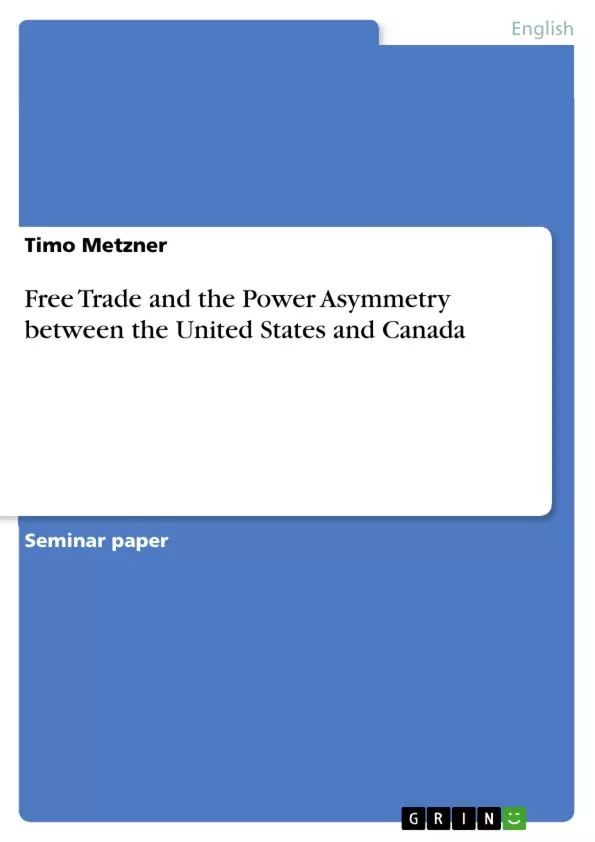This paper will address the question what strategic goals stood behind the promotion and implementation of free trade between the United States and Canada. The purpose is to evaluate the Canada-U.S. Free Trade Agreement (CUFTA) and the North American Free Trade Agreement (NAFTA) in respect to the objectives of both parties that were not commonly shared in the beginning. It is about the consequences of power imbalance for regional free trade and not about the social costs that are intensively discussed and certainly heavily felt in both countries. Since the view of a power asymmetry that exists between the two countries should be rather uncontested, the central idea of the following text is to examine in detail at which points this has shaped the content of the two agreements. This approach is inspired by the broader question, whose interests free trade serves in general. An important rhetoric strategy of promoters of the neo-liberal agenda is to suggest that the free play of market forces encouraged by such agreements gives all participants the same fair opportunities to engage in trade without intervention from governments. Consequently, all members of the distinct community will benefit from freer trade. For it is rather clear that power and national interests always play a role in politics – in this case in the processes leading to free trade agreements – it shall be demonstrated how this works in particular.
Inhaltsverzeichnis (Table of Contents)
- Introduction
- The U.S.: Objectives for Engaging in Regional Free Trade
- Strategic Interests versus Canada
- Precedents for GATT and WTO
- Canada: Objectives for Engaging in Regional Free Trade
- An Approach to Secure Market Access
- General Dispute Settlement
- Power Asymmetry with Consequences?
- Conclusion
- References
Zielsetzung und Themenschwerpunkte (Objectives and Key Themes)
This paper investigates the strategic motivations behind the establishment of free trade between the United States and Canada. It aims to evaluate the Canada-U.S. Free Trade Agreement (CUFTA) and the North American Free Trade Agreement (NAFTA) by considering the distinct objectives of both parties. The focus is on the consequences of power imbalances in the context of regional free trade, examining how these imbalances shaped the content of the agreements. The analysis is inspired by the broader question of whose interests free trade serves.
- The strategic goals of the U.S. and Canada in negotiating free trade agreements.
- The impact of power asymmetry on the content and implementation of CUFTA and NAFTA.
- The role of domestic political agendas in shaping trade policy.
- The effectiveness of dispute resolution mechanisms in addressing trade imbalances.
- The influence of the free market ideology on trade policy.
Zusammenfassung der Kapitel (Chapter Summaries)
The introduction sets the stage for the analysis, outlining the research question and the key themes of the paper. It emphasizes the importance of understanding the role of power dynamics in free trade agreements. Chapter 2 focuses on the United States' objectives for engaging in regional free trade, highlighting the importance of secure market access, the inclusion of the energy sector, and the protection of intellectual property rights. Chapter 3 examines Canada's objectives, particularly its focus on securing market access and mitigating the potential negative consequences of U.S. trade remedy measures. Chapter 4 delves into the consequences of power asymmetry, exploring how it impacts the negotiation and implementation of free trade agreements. Chapter 5, the conclusion, is not included in this preview.
Schlüsselwörter (Keywords)
Key terms and concepts explored in this paper include regional free trade, power asymmetry, Canada-U.S. Free Trade Agreement (CUFTA), North American Free Trade Agreement (NAFTA), strategic objectives, market access, dispute resolution mechanisms, energy sector, intellectual property rights, trade remedies, and neo-liberal agenda. These terms are central to understanding the political and economic dynamics shaping the relationship between the United States and Canada in the context of free trade.
- Quote paper
- Magister Artium Timo Metzner (Author), 2004, Free Trade and the Power Asymmetry between the United States and Canada, Munich, GRIN Verlag, https://www.hausarbeiten.de/document/162583


